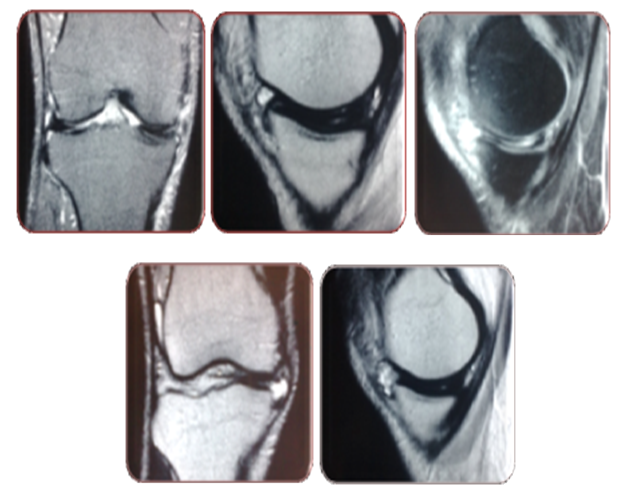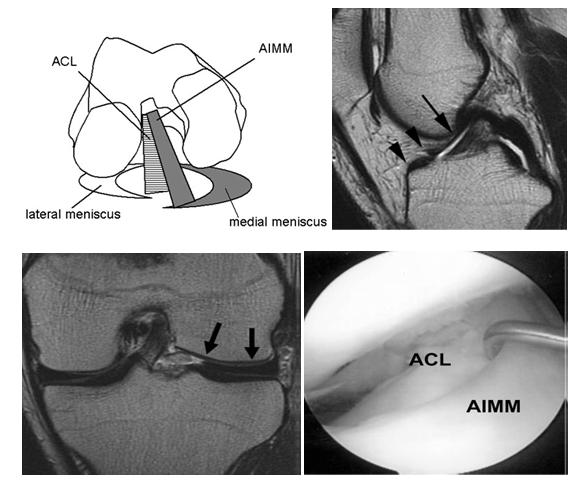MOJ
eISSN: 2374-6939


Case Report Volume 2 Issue 3
Pontifical Catholic University of Sao Paulo, Brazil
Correspondence: Nilesh Vishwakarma, Pontifical Catholic University of Sao Paulo, Rua Caracas, Sorocaba, Sao Paulo, Brazil, Tel 32334171
Received: February 22, 2015 | Published: April 8, 2015
Citation: Vishwakarma N, Kini A, Joshiz A, et al. Pathognomic discoid medial meniscus with a parameniscal cyst: a case report and literature review of anomalous medial meniscus variants. MOJ Orthop Rheumatol. 2015;2(3):111-113. DOI: 10.15406/mojor.2015.02.00052
Discoid medial meniscus is an extremely rare anomaly with an incidence of 0.1-0.3%. Only 35 cases have been reported in literature so far. The association of a Parameniscal cyst with a discoid medial meniscus has been not described in literature to our knowledge. The cyst related to the discoid medial meniscus was anteromedial in location as compared to the lateral discoid meniscus cyst which usually is in lateral or postero-lateral in position.
We present a case report of a complete discoid medial meniscus with a parameniscal cyst which was treated successfully by excision of the central anomalous part of the meniscus and cyst decompression. The presentation differs drastically as compared to a discoid lateral meniscus and the age of presentation is also not defined due to rarity of such cases. The discoid medial meniscus developed a horizontal cleavage tear and consequently a parameniscal cyst which became symptomatic insidiously. Physical examination revealed medial joint line tenderness with Thessaly test and Steinman II tests positive (Figure 1).
Controversy exists with regards to the etiology of discoid medial meniscus wherein Kaplan in 1974 stated that congenital alteration in the attachment of posterior horn of the meniscus by the meniscofemoral ligament which becomes hypermobile and Smillie postulated that menisci exist as cartilaginous disc at an early stage in development and congenital discoid meniscus is attributable to persistence of the disc shape at varying stages of embryonic development.
Various anomalies reported include anterior horn hypoplasia, anomalous posterior horn attachment to lateral femoral condyle, anomalous insertion of anterior horn to ACL, anterior transportation of the anterior medial meniscus below the anterior edge of the tibial plateau and the anterior horn contiguous with the ACL, increased tibial plateau concavity with elongated medial tibial spine and lastly bilateral occurance.
Keywords: Discoid, Medial, Meniscus
Discoid medial meniscus was reported for first time by Cave and Staples in 1941.1 It is an extremely rare anomaly with an incidence of 0.1-0.3%.2 Only 35 cases have been reported in literature so far.3 We present a case report of a complete discoid medial meniscus associated with an anteromedial parameniscal cyst which was treated successfully by excision of the central anomalous part of the meniscus and cyst decompression. The discoid medial meniscus associated with a parameniscal cyst has not been described previously in the literature.
A 42 year old male consulted at arthroscopy and sports medicine institute because of right anteromedial knee pain on complete knee straightening and occasional limp and swelling on exertion. The pain was of 8 months duration, without any previous history of trauma, fall, either direct or indirect and was insidious in origin, and gradually progressive. There was occasional catching sensation especially on near complete knee extension. The pivoting activities was accompanied by pain and limp later and gradually progressed, affecting activities of daily living like prolonged standing ,sitting cross legged and squatting. The patient did notice fullness in the anteromedial region on exertion. There was no rest pain and no constitutional symptoms. Clinically, the medial joint line was tender and, Steinman II and Thessaly test were positive4 (Figure 2). He had full range of motion with pain only on terminal extension localizing medially. The lachman, pivot shift was negative. Radiographs were seemingly normal with a flat medial plateau with MRI showing a bow-tie sign persisting in all sagittal images of medial meniscus with a grade 2 signal intensity (Figure 3).

Figure 3 MRI findings (a) Coronal view confirming discoid medial meniscus, (b) Persistence of Bow-tie sign on sagittal view (c)Horizontal cleavage (d,e) Anteromedial location of cyst.
Arthroscopy confirmed an almost complete discoid medial meniscus with the free margin in contact with the ACL stump, without any evidence of abnormal attachment to ACL and medial tibial spine. The central anomalous portion of the discoid meniscus was excised arthroscopically revealing a horizontal cleavage. The cyst got decompressed once the mid segment and anterior segment junction was excised. A minimal yellow colored thick fluid was expelled during excision. Partial meniscectomy was completed leaving a well balanced peripheral rim. Post operatively the patient reported significant improvement in the VAS score from 8 to 1 (Figure 4). Physiotherapy was begun in immediate postoperative period and the recovery was good with no pain at the end of 1 week (VAS score 0) and patient did resume recreational sports after 1 month.
The first true discoid medial meniscus was reported by Cave & Staples.1,5 Smillie theory states that menisci exist as cartilaginous disc at an early stage in the development and congenital discoid meniscus is attributable to the persistence of the disc shape at varying stages of embryonic development, whereas Kaplan postulated in 1974 that discoid menisci are acquired after birth and are related to congenital alteration in the attachment of the meniscus posterior horn by the menisco-femoral ligament thus making it a pathologic entity rather than a congenital anomaly.2 Anatomical studies by Clark and Ogden have demonstrated that anterior extensions from both menisci to anterior cruciate ligaments can be present after birth.3
Only a few reports of anomalous insertion of the medial meniscus exist (Figure 5), and they include abnormal insertion of the medial meniscus into the anterior cruciate ligament,6 anomalous insertion of the anterior horn of the medial meniscus into the intercondylar notch of the femur with an absent transverse meniscal ligament7 and a case of an anomalous band in continuity with the medial meniscus that extended from the posterior horn area of the medial meniscus to insert into the mid portion of the anterior cruciate ligament.8 Other anomalies (variants) of the medial meniscus described in the literature include discoid variants, discoid variants associated with a cyst, discoid medial meniscus bilaterally, absent fixation of the transverse meniscal ligament to the tibial plateau, buckled meniscus, hypoplasia of the anterior horn, the posterior horn, the entire meniscus, the ACL, and anomalous attachment of the posterior horn.9 In a morphologic study of 48 cadaveric knees, reported four tibial insertion locations of the medial meniscus. Type I insertions were located in the flat intercondylar region of the tibial plateau; type II occurred on the downward slope from the medial articular plateau to the intercondylar region; type III occurred on the anterior slope of the tibial plateau; and in type IV there was no firm bony insertion of the anterior horn of the medial meniscus. The occurrence for type I was reported to be 59%; type II, 24% ; type III, 15%; and type IV, 3%.10

Figure 5 Anomalous insertion of the medial meniscus (AIMM) anterior into the anterior cruciate ligament,(a) diagrammatic representation,(b,c) MRI showing anomalous insertion,(d) confirmed on arthroscopy.
In an arthroscopic study of variants of the anterior horn of the medical meniscus the authors classified medial meniscus insertion into the following four categories, the ACL (anterior cruciate ligament) type, where the anterior horn of the medial meniscus was attached to the ACL; the transverse ligament type, where the anterior horn of the medial meniscus was attached to the transverse ligament; the coronary ligament type, where the anterior horn of the medial meniscus was attached to the coronary ligament; and the infrapatellar fold type, where the anterior horn of the medial meniscus was attached to the infrapatellar synovial fold.11–16 J-G CHA et al.12 found that the prevalence of a medial discoid meniscus in patients with Anomalous insertion of medial meniscus (AIMMs) on ACL was much higher than reported. Anomalous insertion of medial meniscus on ACL has a closer connection with a medial discoid meniscus than a lateral discoid meniscus [10]. Radiographic findings are uncommon in cases of medial discoid menisci.13,17
However, Lowenberg & Feldman14 in 1993 mentioned medial joint space widening and flattening of the medial tibial condylar epiphysis.1 The bone changes did get resolved as reported by Weiner et al.15 The symptoms are drastically different from a discoid lateral meniscus and age of presentation is also not well defined as the incidence itself is very rare. The discoid medial meniscus in our report presented with pain and swelling with limp on exertion and clinically was indisguisable from a typical degenerative medial meniscus tear. The meniscus was excised to a balanced margin and the peripheral attachment was well preserved.

©2015 Vishwakarma, et al. This is an open access article distributed under the terms of the, which permits unrestricted use, distribution, and build upon your work non-commercially.